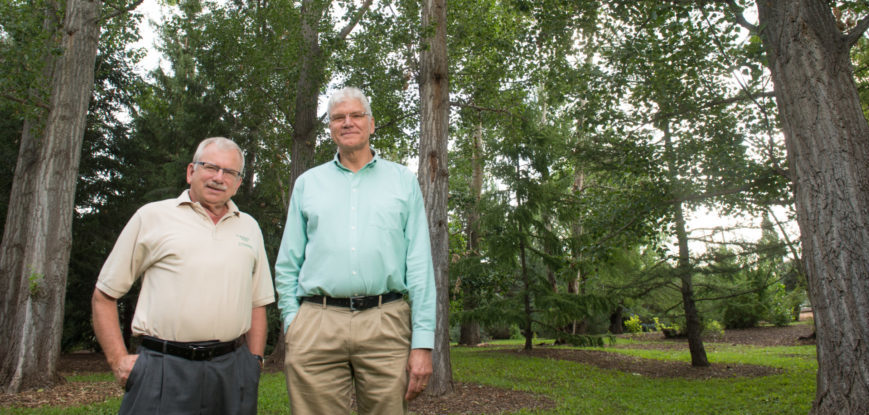
Green is gold — at least at Colorado State University — and it’s not just the new buildings that are reshaping campus. Two new gardens will add to the already iconic, beautiful green spaces for students and the CSU community to enjoy for years to come.
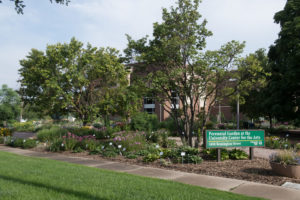
Creating a Garden and Arts District
One of the new gardens is the Perennial Garden at the University Center for the Arts, formerly located on Lake Street and now on the northwest corner of Pitkin and Remington streets. Jim Klett, longtime professor of landscape horticulture, ornamentals, and nursery management, created the iconic garden 36 years ago “out of a patch of dirt” on West Lake Street at the southwestern corner of the main campus.
When CSU’s Annual Flower Trial Garden – another project overseen by Klett – was moved from the same relatively obscure location on Lake Street to its current home in front of the UCA, it became one of the most-visited spots in Fort Collins.
“When we moved the Trial Garden it became much more visible and really brought a lot of positive attention to the program,” Klett said. “I’m hoping the change will have the same impact on [the perennial garden].”
The addition of the new perennial garden inspired CSU and city officials to dub the area the CSU/Fort Collins Garden and Arts District, which includes thousands of plants and outdoor sculptures.

“The Perennial Garden, the Annual Flower Trial Garden, the Gregory Allicar Museum of Art and the Avenir Museum in the University Center of the Arts, come together to create a vibrant gardens and arts district for the campus and the greater Northern Colorado community,” said Fred Haberecht, assistant director of Facilities Management.
A CSU gem
When CSU acquired the old Fort Collins High School in 2000, with plans to turn it into the University Center for the Arts, it came with a 2.5-acre park in front. Klett and an advisory committee worked to move and expand the Annual Flower Trial Garden into the space.
A northern Colorado showpiece and CSU gem, the Trial Garden is the largest university trial garden west of the Mississippi River. The garden draws visitors from near and far, but has a distinct research focus: The cultivars planted here are scrutinized for their ability to flourish in Colorado’s harsh growing conditions, and the varieties deemed winners are touted to home gardeners who want to cultivate their green thumbs.
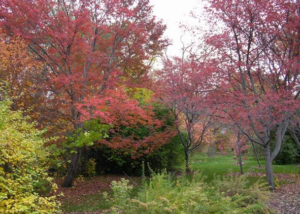
Other university green spaces
While the Trial Gardens have become one of the top tourist attractions in Fort Collins during growing season, the CSU campus is defined by its gardens and green spaces.
A garden devoted to trees
CSU has the largest collection of woody plants in the region with over 1,100 different kinds represented. The existing 5.5-acre Arboretum near the new on-campus stadium will be enhanced with additional paths and tree identification guides. Many trees in the Arboretum are more than 35 years old and were planted under the leadership of Klett, who has dedicated several decades to creating and nurturing the arboretum to serve as research, academic and public education resources to the university. The arboretum was planted to demonstrate the vast diversity of trees that grow well in Colorado’s climate.
The Great Green
The expansive lawn to the west of the Lory Student Center and the intramural practice fields just south of the award-winning Recreation Center make up the Great Green. This Great Green contains 42 acres of lawn and trees.
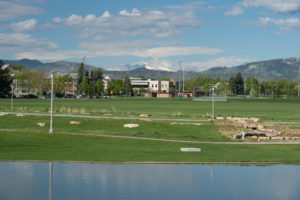
“This area of campus is very externally focused,” said Haberecht. “It’s the spot where you can stand and see the ‘A,’ Horsetooth Rock and Longs Peak. It’s a space that very much brings Colorado into the campus. This green space has been intentionally maintained on the campus, even with the new construction. The campus community knows what a special place it is and how much it speaks to who we are as Colorado State University.”
In this area of campus, students can enjoy the tranquility of the Lagoon or, during the summer, catch a free concert with some of the best local bands during the Lagoon Concert Series. The Vietnam Era Memorial Bridge, near the Lagoon, is an important part of campus. Bricks from Old Main, built in 1870 and destroyed in a fire in 1970, were used in the construction of the bridge.
The Great Green provides a wide-open space for all kinds of student recreation and enjoyment.
“It’s important for students to know that green spaces like the Great Green are the framework of campus,” said Haberecht. “The Great Green, which constitutes 10 percent of the campus, helps define student life. It’s connected to the Recreation Center, Moby Arena, Student Center, Library and student housing. This important green space works hand in glove with student life.”
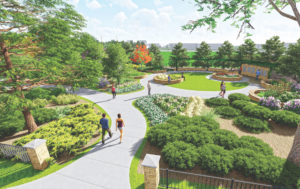
Ag history on display at new Heritage Garden
CSU’s rich agricultural history will be on display at the new Heritage Garden near the new on-campus.
The Heritage Garden, on the south side of the new football practice fields, will serve as a gateway to the iconic arboretum directly to the west. The Heritage Garden will occupy the space that previously planted with the perennial garden that has been moved to the University Center for the Arts.
The Heritage Garden will serve as a showcase for Colorado’s agricultural diversity. Six raised beds will feature crops that represent various regions of the state.
“The vision for the Heritage Garden is to tell the story of Colorado agriculture and Colorado State University’s role within it,” said Ajay Menon, dean of the College of Agricultural Sciences. “Our goal is to highlight and inform the visiting public, students and alumni about the history, nature and impact of agricultural research, teaching and engagement at CSU. We envision this space to speak to our university’s efforts to be Colorado-focused for global impact across all dimensions of the food, water and energy nexus.”
The garden is projected to open in 2018, with planting taking place in the spring.
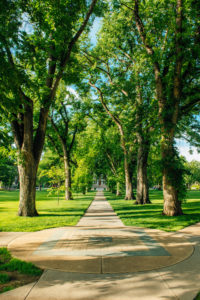
Heart of campus: the iconic Oval
The heart of the campus is the Oval. The university’s Oval is known for its giant elm trees, many of which date from the 1880s and 1920s. The size and beauty of the trees make the Oval a popular icon of the university, likely the most photographed location on campus, as well as a site for graduation celebrations, weddings and festivals.
It’s said that a true Ram has a heart shaped like an Oval.
There are 99 elms circling the Oval and lining its walkways, with about 40 more trees nearby, outside of Oval Drive. Some of the trees are 80 to 90 feet high, with roots that are one-and-a-half times their height.
Today, Facilities Management maintains routine pruning of the trees to help prevent damage and keep the trees healthy, an investment of $125,000 or more each time the trees are pruned. Costs are supported through university funds. The Oval Tree Preservation Endowment was created several years ago to devote resources specifically to preserving the elms. To support the Oval Preservation Fund, visit the website.
“If our campus is successful at creating these special places, then it’s a campus where you could say, I’ll meet you at the … name the specific location,” said Haberecht. “When we start getting identifiable spaces that have resonance in people’s memory, then we’ve got something special, like ‘I’ll meet you at the Oval.’ That becomes something that will be meaningful for a lifetime.”